Standard Fences for Cottage Communities: Advantages and Disadvantages
In cottage communities, which are often isolated from the surrounding landscapes, their own infrastructure is frequently developed. Therefore, the requirements for fences installed in such areas will be unique. Despite the fact that the rules for cottage community construction often regulate the choice of fencing structures, sometimes the decision is made by the landowner. In this case, it is essential to consider the advantages and disadvantages of all available options and focus on the most relevant characteristics.
WHAT SHOULD A FENCE BE LIKE FOR A COTTAGE COMMUNITY?
A cottage community or settlement is an area with a high degree of isolation. Typically, entry into it is restricted, as is passage, so the level of security within the settlement is significantly higher than outside its boundaries. This has an impact on the style and lifestyle in suburban and cottage communities and on what characteristics of fences will be prioritized.
When choosing a fence for a cottage community, several factors need to be taken into account, such as functionality, aesthetics, privacy, and security. Here are some recommendations for choosing a fence for a cottage community:
- Fence Material: Popular material options for fences include wood, metal, and stone. Each material has its advantages and disadvantages. For example, a wooden fence creates a warm and natural atmosphere but requires regular maintenance. Metal fences can be sturdy and secure but may look less attractive. The choice of material depends on your preferences and requirements.
- Height and Design: The height of the fence should be sufficient to provide privacy for residents and prevent unauthorized access. Typically, a fence height of 1.5 to 2.5 meters is recommended. The fence’s design can be solid for increased privacy or have gaps between elements to maintain visibility and airflow.
- Decorativeness: A fence can serve not only a functional but also a decorative purpose in a cottage community. Different styles and ornaments can add beauty and individuality to the overall appearance of the community.
- Compliance with Local Regulations: When choosing a fence, it’s essential to consider local building codes and regulations. Consult with local authorities to learn about requirements regarding fence height, materials, and style.
- Budget: Determine your budget in advance and choose a fence that fits your financial capabilities. Different materials and fence styles come with varying costs, so it’s essential to find a balance between quality and affordability.
Unlike standalone cottages, certain factors should be given closer attention in cottage communities, such as privacy and aesthetics. While the strength of the fence is essential, it’s also crucial to consider:
- Privacy: If you have friendly neighbors, that’s great. But if you’re less fortunate, protection from prying eyes is essential.
- Aesthetics: The fence should not only look good on its own but also harmonize with the building’s landscape.
- Durability: The protective structure should not lose its strength and attractiveness due to climatic factors such as moisture, wind, UV radiation, and temperature fluctuations.
These are the priorities we will consider when analyzing typical fencing structures. However, it’s important to take other factors into account during the analysis.
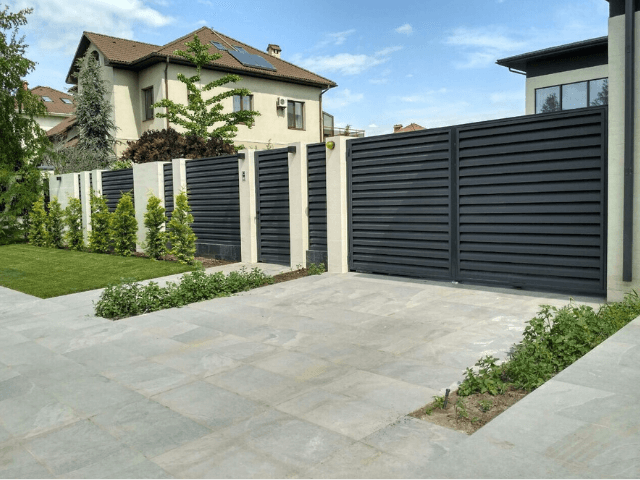
Wooden Fences
A “classic” solution, familiar to us from American and European films, is the low wooden picket fence. However, this option is more suitable for townhouses in the United States or Europe than for a cottage community in Ukraine.

Advantages
Wooden picket fences have many advantages:
- Affordable price, especially in regions with their forests.
- Variety of designs.
- Wide color palette (wood can be painted in any shade).
- Eco-friendliness.
- Ability to build fences of any height and with any design, both solid and ventilated.
Disadvantages
However, wooden fences cannot be considered a universal solution for several reasons:
- Vulnerability to climate factors. Even with quality wood treatment, it can rot due to moisture and darken under the influence of UV radiation.
- Limited service life due to the above-mentioned vulnerability.
- Wooden fences require maintenance. They need to be repainted every two years, and every 4-5 years, old paint should be removed and reapplied. Neglecting maintenance can lead to an untidy appearance.
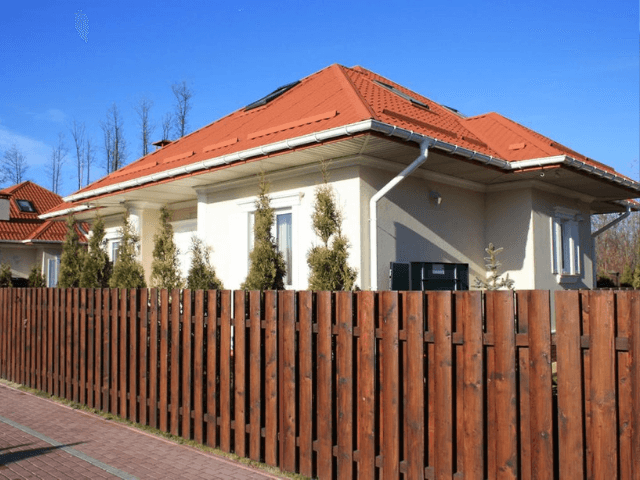
Concrete or Brick Fences
Next in popularity are concrete and brick fences. Solid concrete sections are installed to minimize the budget load, while brick fences (both solid and combined with wrought iron grids) fall into the “costly” category.
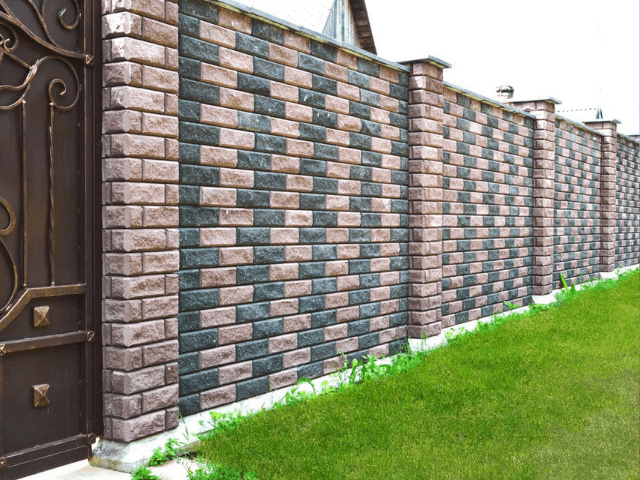
Advantages
Concrete and brick fences also have numerous advantages:
- High mechanical strength.
- High privacy (at sufficient height).
- A solid and imposing appearance.
- Good resistance to climatic influences (when using high-quality materials).
Disadvantages
However, the widespread use of concrete and brick fences is limited by their characteristic drawbacks. The most significant ones include:
- Significant weight. While this isn’t an issue overall, a heavy fence can only be safely installed on a deep and sturdy (and therefore expensive) foundation, and not on any type of soil.
- Complexity of construction. This is the number one problem for brick and stone fences. It’s not enough to buy and deliver the materials; you also need to find experienced masons who will spend at least a month (minimum!) building this fence.
- Price. You can find inexpensive options, but their appearance will correspondingly be less attractive. Therefore, be prepared from the outset that constructing a brick or stone fence is not a cheap endeavor.
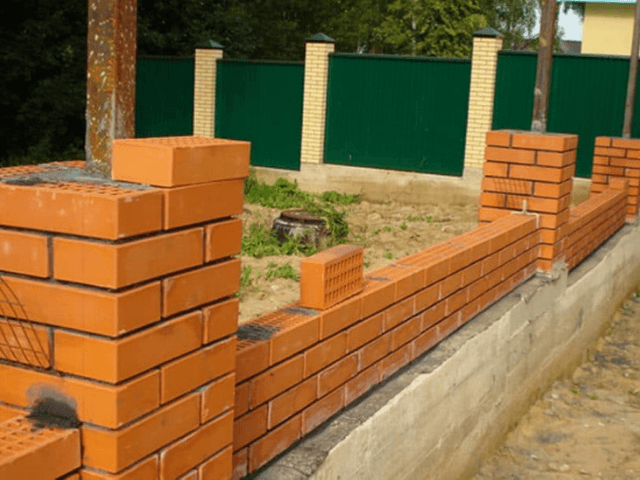
Some experts in the construction market also mention the limited variety of designs as a disadvantage. It’s challenging to say how true this is, but in some projects, a massive stone or concrete fence may indeed be inappropriate.
Metal Panel Fences
The use of metal in the production of fences for cottage communities used to be limited due to the lack of coatings resistant to moisture and UV radiation. Sometimes, chain-link and lattice fences were used, but more often as temporary or auxiliary fences. However, with the introduction of panel structures with protective decorative polymer coating to the market, metal fences have begun to expand their niche in cottage construction rapidly.
Advantages
Among all available options, metal fences have perhaps the most extensive list of advantages:
- Combination of strength and minimal weight. The use of lightweight profiled slats allows minimizing the load on the foundation (hence saving on the foundation) while maintaining the fence’s strength.
- Resistance to climatic influences. About 15 years ago, people were wary of metal fences due to concerns about corrosion. Nowadays, the situation has changed significantly: coatings based on polyester, polyurethane, plastisol, or PVDF not only provide decoration but also almost entirely eliminate the risk of corrosion. This also applies to wind erosion and resistance to UV radiation – the polymer layer has very high durability.
- High technology. This lies not so much in the simplicity of installation but in the fact that metal can be used to make fences of almost any size and configuration. This greatly expands the range of available solutions: if needed, you can install a solid fence for maximum privacy, or choose a ventilated fence or a louvered structure that allows airflow but conceals what’s happening on the plot.
Adding an attractive appearance to the list of advantages is worth mentioning as well. Even the simplest monochrome metal fence looks neat and harmonizes excellently with the European style of most cottage communities. There’s always the possibility to realize exclusive design by choosing a non-standard color or ordering slats stylized to look like natural wood (for example, at the Mehbud factory, high-precision offset printing technology on metal, called PRINTECH, is used for decorating such details).
Disadvantages
The main drawback of metal fences is their price, but two clarifications need to be made:
- Firstly, the cost of such fences is gradually decreasing, so if you thought the amount was unaffordable five years ago, it’s worth looking through catalogs again. The likelihood that more affordable options have appeared in the assortment is close to 100%.
- Secondly, the service life of metal fences is quite long, making the purchase and installation of a metal fence a cost-effective long-term investment.
There is one more drawback – sensitivity to the quality of installation. Incorrect and sloppy installation can lead to rust development in areas with scratches and other damage on the metal base. This issue can be solved in one way – entrust the installation of a metal fence to professionals.
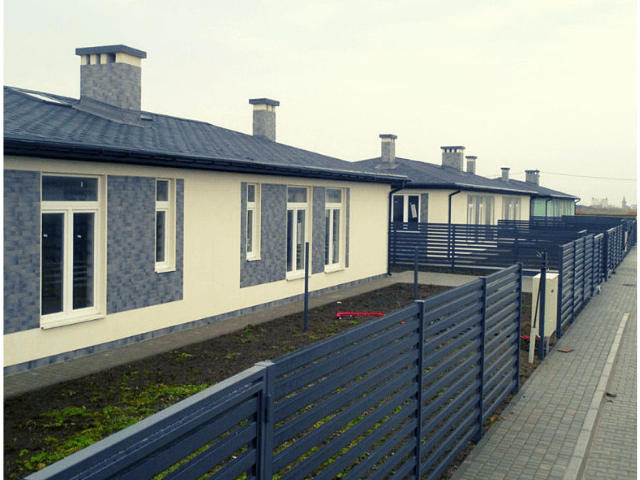
Fencing plots within cottage communities can be done using various structures, differing in both material and characteristics. However, recently, the trend becomes quite clear – metal fences, if not occupying the largest share of the market, are rapidly gaining popularity, displacing more traditional but less practical wooden and concrete fences.
